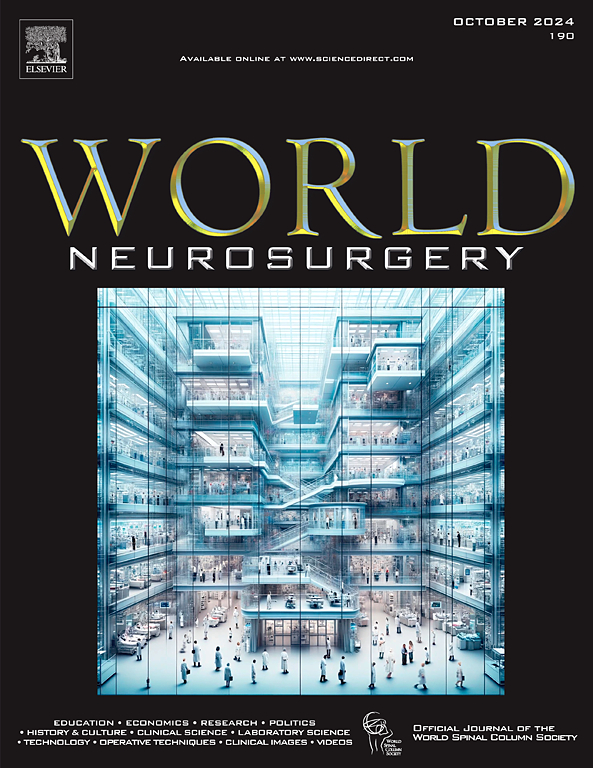中国东部颅内动脉瘤的治疗前景:技术采用和结果的倾向匹配分析(2018-2022)。
IF 1.9
4区 医学
Q3 CLINICAL NEUROLOGY
引用次数: 0
摘要
目的:分析中国东部地区颅内动脉瘤(IAs)的治疗趋势和预后,比较显微外科夹闭(SC)和血管内卷曲(EC),探讨影响治疗决策的临床和社会经济因素。方法:对2018-2022年间治疗的2720例动脉瘤2811例进行多中心回顾性研究。倾向评分匹配(PSM)比较了手术程序和临床结果,而多变量逻辑回归确定了治疗选择的决定因素。年增长率采用复合年增长率(CAGR)计算。结果:1281例IAs (RIA)破裂患者中,533例行SC, 748例行EC。在1439例未破裂性IAs (UIA)患者中,1295例(90%)接受了EC治疗。psm后分析显示,EC手术时间短,并发症少,但费用和复发风险较高。对于UIAs和GCS评分较高的患者优先选择EC,对于复杂动脉瘤和严重临床病例选择SC。值得注意的是,电子商务的采用显著增加,ria的复合年增长率为16.3%,uia的复合年增长率为19.1%,突出了向技术偏好的转变。结论:这是中国东部地区首个将临床结果与社会经济因素相结合的IA治疗多中心研究。研究结果表明,EC越来越受到青睐,特别是对于uia,但SC仍然是复杂病例的必要条件。这两种方法都有明显的优势,应该在临床疗效和经济现实的背景下考虑。本文章由计算机程序翻译,如有差异,请以英文原文为准。
Treatment Landscape of Intracranial Aneurysms in Eastern China: A Propensity-Matched Analysis of Technique Adoption and Outcomes (2018–2022)
Objective
To analyze treatment trends and outcomes for intracranial aneurysms (IAs) in Eastern China, comparing microsurgical clipping (SC) and endovascular coiling (EC), and exploring clinical and socioeconomic factors influencing treatment decisions.
Methods
A multicenter retrospective study of 2720 patients with 2811 aneurysms treated between 2018 and 2022 was conducted. Propensity score matching compared surgical procedures and clinical outcomes, while multivariable logistic regression identified determinants of treatment choice. Annual growth rates were calculated using compound annual growth rate.
Results
Of 1281 patients with ruptured IAs, 533 underwent SC and 748 received EC. For 1439 patients with unruptured IAs (UIAs), 1295 (90%) were treated with EC. Post-propensity score matching analysis showed EC had shorter operative times, fewer complications, but higher costs and recurrence risks. EC was preferred for UIAs and patients with higher Glasgow Coma Scale scores, while SC was chosen for complex aneurysms and severe clinical cases. Notably, EC adoption increased significantly, with a compound annual growth rate of 16.3% for ruptured IAs and 19.1% for UIAs, highlighting a shift toward technological preference.
Conclusions
This is the first multicenter study on IA treatment in Eastern China, integrating clinical outcomes with socioeconomic factors. Findings suggest EC is increasingly favored, particularly for UIAs, but SC remains essential for complex cases. Both approaches offer distinct advantages and should be considered in the context of clinical efficacy and economic realities.
求助全文
通过发布文献求助,成功后即可免费获取论文全文。
去求助
来源期刊

World neurosurgery
CLINICAL NEUROLOGY-SURGERY
CiteScore
3.90
自引率
15.00%
发文量
1765
审稿时长
47 days
期刊介绍:
World Neurosurgery has an open access mirror journal World Neurosurgery: X, sharing the same aims and scope, editorial team, submission system and rigorous peer review.
The journal''s mission is to:
-To provide a first-class international forum and a 2-way conduit for dialogue that is relevant to neurosurgeons and providers who care for neurosurgery patients. The categories of the exchanged information include clinical and basic science, as well as global information that provide social, political, educational, economic, cultural or societal insights and knowledge that are of significance and relevance to worldwide neurosurgery patient care.
-To act as a primary intellectual catalyst for the stimulation of creativity, the creation of new knowledge, and the enhancement of quality neurosurgical care worldwide.
-To provide a forum for communication that enriches the lives of all neurosurgeons and their colleagues; and, in so doing, enriches the lives of their patients.
Topics to be addressed in World Neurosurgery include: EDUCATION, ECONOMICS, RESEARCH, POLITICS, HISTORY, CULTURE, CLINICAL SCIENCE, LABORATORY SCIENCE, TECHNOLOGY, OPERATIVE TECHNIQUES, CLINICAL IMAGES, VIDEOS
 求助内容:
求助内容: 应助结果提醒方式:
应助结果提醒方式:


